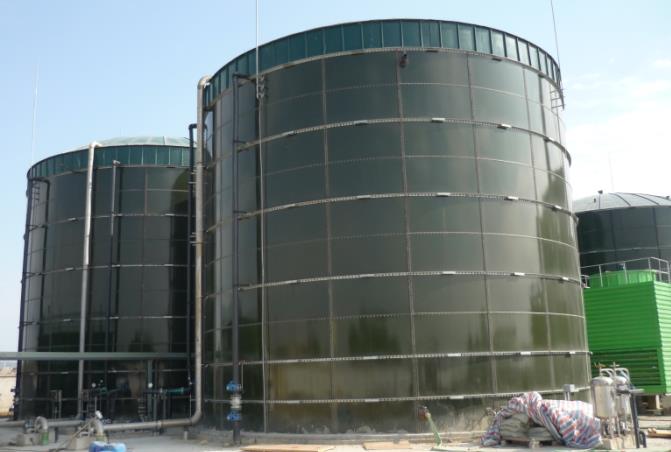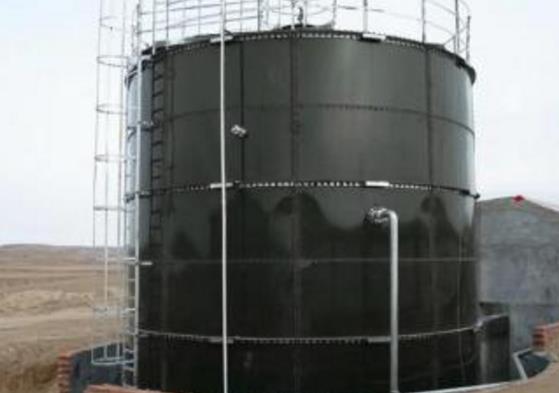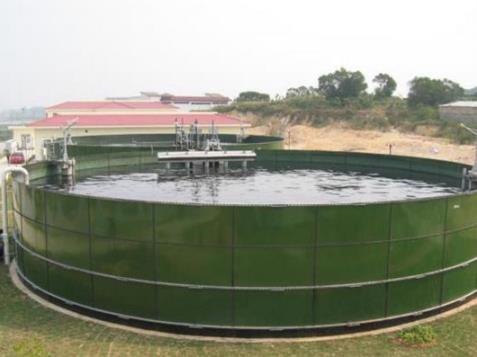bio digester tank
2018-11-05 18:39:50 By:NVirotech Bolted Tank (2562)
bio digester tank of bolted tank
Digestion sludge is also known as cooked sludge. Digestion is carried out in a bio digester tank under aerobic or anaerobic conditions, so that the content of volatile matter in the sludge is reduced to solid, relatively non-decaying, odor-free sludge. Its moisture content is about 95%, which is easy to dehydrate.
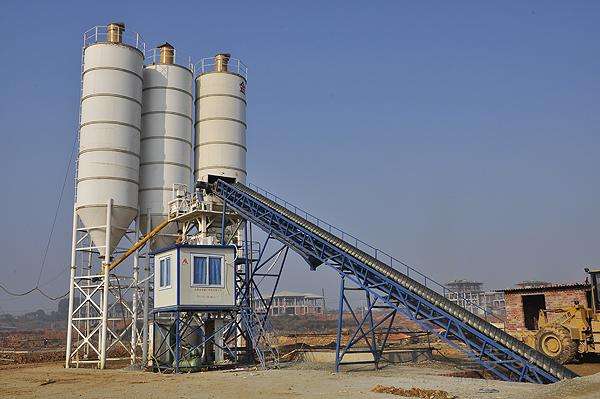
Sludge digestion is the stabilization of organic matter in sludge by utilizing the metabolism of microorganisms. When the VSS content of volatile solids in sludge is below 40%, it can be considered stable. Aerobic digestion and anaerobic treatment can be used for sludge digestion.
Oxygen-consuming sludge digestion is to oxidize organic matter in sludge by oxygen-consuming method, and reduce the quality and volume of sludge. Operating sludge aerobic digestion is like operating an activated sludge system.
As long as the microbial environment is stable (such as temperature, pH, non-toxic substances interference), the system will be self-sustaining.
Anaerobic digestion is a sludge treatment process which uses facultative bacteria and anaerobic bacteria for anaerobic biochemical reactions to decompose organic substances in sludge. Anaerobic digestion is the main link to achieve "four modernizations" of sludge. First, the decomposition of organic matter by anaerobic digestion can stabilize the sludge and make it less corrupt. Secondly, through anaerobic digestion, most pathogenic bacteria or roundworm eggs are killed or decomposed as organic matter, making the sludge harmless.
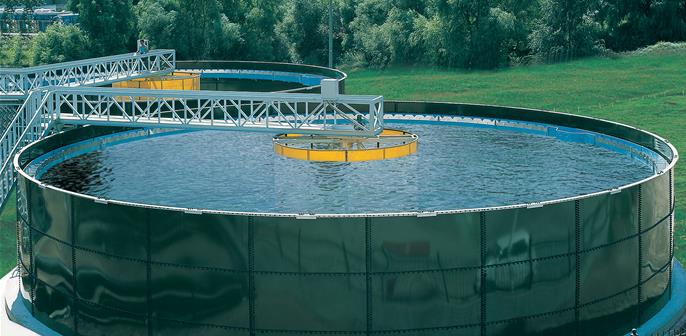
bolted steel water tank specifications
Thirdly, with the stabilization of sludge, a large number of biogas with high calorific value will be produced, which will be used as energy resources to make sludge resource. In addition, after digestion, some of the organic nitrogen in the sludge is converted into ammonia nitrogen, which improves the fertilizer efficiency of the sludge. Although sludge reduction mainly depends on concentration and dehydration, organic matter is anaerobically decomposed and converted into biogas, which is itself a reduction process.
Anaerobic sludge digestion process mainly consists of two stages: acidification stage and methanation stage. The main components of solid organic compounds are natural macromolecule compounds, such as starch, cellulose, oil and protein, which are degraded into liquid products such as organic acids, alcohols, aldehydes, water molecules and gaseous molecules such as CO2, H2, NH3, H2S in an anaerobic environment.
Most of the gases are dissolved in mud. The conversion products were mainly organic acids at that stage, so the pH value decreased rapidly. Low pH value can inhibit the growth of bacteria, while NH4OH, the dissolution product of NH3, can neutralize the growth of bacteria. After a long period of acidification, the pH value rises and enters the gasification stage. The gasification stage produces mainly methane, so it is also called methanation stage, which corresponds to acidification stage. There are more CO2 in this stage, as well as trace H2S. Some scholars believe that anaerobic sludge digestion experiences four stages: hydrolysis, acidification, acetification, methanation.
It mainly includes bacteria, fungi and protozoa. Bacteria include cellulose-decomposing bacteria, carbohydrate-decomposing bacteria, protein-decomposing bacteria and fat-decomposing bacteria. Fungi include Mucor, Rhizopus, Aspergillus and copperhead. Protozoa include flagellates, ciliates and amoebae.
Hydrogen producing Acetobacter and homotypic Acetobacter.
Methanogens mainly include methanogens, methanogens, methanogens and methanillobacter spp. eight.
bio digester tank in china
Sludge contains a lot of toxic substances, such as bacteria, pathogenic microorganisms, parasitic eggs, extremely unhygienic. In the process of sludge digestion, methanogens produced by methanogens have a strong antibacterial effect, can kill most of the pathogenic bacteria and other harmful microorganisms, so that sludge sanitation.
Under aerobic conditions, microorganisms absorb excessive amounts of phosphorus from wastewater, and then remove phosphorus from the system by removing sludge. Some of the phosphorus in the sewage is discharged with the excess sludge, and most of the phosphorus-containing sludge and sewage return to the anaerobic state together. Under the disadvantageous condition of anaerobic, the phosphorus-accumulating bacteria in the activated sludge decompose the phosphorus in the body to produce energy, part of the energy is supplied for their own survival, the other part is supplied to the phosphorus-accumulating bacteria The acetic anhydride was collected and converted into PHB and stored in the body.
When polyphosphate bacteria decompose phosphorus, phosphorus can be released into the mud. Under aerobic conditions, microorganisms will accumulate in the body of PHB decomposition release a lot of energy, part of the supply of their own growth and reproduction, part of the supply of phosphorus accumulating bacteria to absorb a large number of phosphorus in the mud, which is aerobic phosphorus absorption.
All individuals of the specified species of microorganisms in the reactor system are the same. In fact, each microorganism has a different physiological state due to its different life cycle stages.
Then the phenomenon can be ignored, that is, any random differences between cells are not considered.
In each functional group of microorganisms (e.g., aerobic heterotrophic bacteria, autotrophic bacteria, etc.), all microorganisms are considered to belong to the same species and their individuals are not considered in a single microbial species, because we are concerned with the microbial community as a whole.
It is assumed that the suspension growth reactor reacts evenly, although the microorganisms in the reactor are at different stages of growth.
bio digester tank is the final product of sewage treatment. It has no harmful pollution to the environment. Since the sewage treatment, the practice has been carried out on the utilization of agricultural sludge. Comparing the composition of sewage sludge with that of manure, it is clear that sludge can be used extensively because it can be used as an organic component of soil and as a fertilizer and a nutrient element for plants.
Therefore, sewage sludge is already needed in agricultural production, sewage sludge is a potential source of recycling nutrients, the following data fully illustrate this problem (Kreft, 1983). In 1981, the annual output of sewage sludge reached 350 million m3, equivalent to 30,000 tons of phosphorus and 40,000-50,000 tons of nitrogen, equivalent to 2.2 million marks (DM) in the value of artificial fertilizers. Moreover, the organic matter content is 800000t, peat value is equivalent to 3 billion 600 million Mark.
When one considers that the available phosphorus sources are very limited and that farming soils are threatened by a lack of organic matter, it is clear that agricultural use of sewage sludge is a meaningful thing, not just for economic reasons.
However, agricultural utilization of sewage sludge also needs to be considered. For large sewage plants, the daily output of sewage sludge is large, the area required for field treatment is large, and the transfer distance is long. Successful experience has also been achieved, with the Lower Saxwerband Federal Sewage Treatment Plant putting 381,000 m3 of sludge into farmland in 1982.
This shows that even if a large number of sewage sludge is properly arranged, this method can also be disposed of. New technologies are widely used in large-scale sewage plants to solve these problems, such as mixing sewage sludge with lime, or with organic flocculants such as ferric salts, mechanical dehydration, landfill treatment or combustion in incinerators.
Of course, a small amount of dehydrated sludge will be produced, and then the final treatment will be done. But these methods also have negative effects, such as the loss of pollutants due to gas emissions, the recycling of toxic substances with the scrubbing fluid of gas purification devices to sewage plants, and the encroachment of abandoned wastes on farmland.
In addition to the disputes over excess sludge, the nature of sewage sludge plays an important role in the use of agricultural sludge. In particular, three issues should be further considered. The first is to understand the composition of the sludge supplied, the second is the hygienic barrier, and the third is the content of toxic substances in the sludge.
-
Related News:
- bolted silo for sale
- bolted steel tanks australia
- fire suppression tanks for sale
- bolted sewage ground storage tanks
- factory-coated bolted steel tanks for water storage
- wastewater treatment storage tank manufacturers

